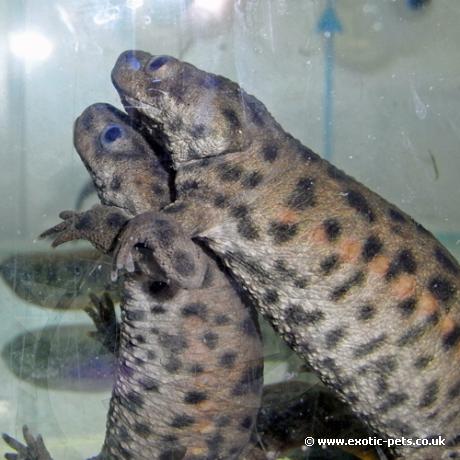

Much like Tylototriton species, Sharp Ribbed Newts can protect themselves against predation with their sharp protruding rib ends. They’re also the largest European species of salamander.
| Origin | Iberian Peninsula and Morocco |
|---|---|
| Environment | Mostly aquatic |
| Adult Size | Up to 30cm |
| Suitability | Beginner |
| Lifespan | Up to 20 years |
A large and robust species of newt that has a flattened appearance allowing it to hide in tight and damp areas during periods of drought. This newt an overall brown and olive mottled effect, with yellow or orange tubercles running along the flanks. The venter (the underside or abdomen of an animal) is a pale yellow or cream and speckled with dark spots.
Adult males have an overall slimmer appearance than females, and during the breeding season will develop swollen cloaca and nuptial pads on their forearms.
These newts can reach staggering lengths of up to 30cm.
Range of freshwater habitats across central and southern Spain, Portugal, and northern Morocco.
These newts can be kept almost completely aquatic, if floating islands are provided. Cork bark is perfect due to its natural buoyancy and gives the newts something to climb on to.
A large glass terrarium of around 90cm in length is advisable due to the size the newts can reach, but expensive heating or lighting equipment is not necessary. Like with all amphibians a low percentage UVB light via an overhead canopy or internal fitting is advisable.
A water temperature of 10-22°C should be maintained year around. Tap water must be treated with a good quality dechlorinator and filtered to avoid the build-up of ammonia and harmful bacteria.
Smooth gravel or river sand is ideal as a base substrate, along with an array of woods, rocks and aquatic plants for décor.
Adults feed voraciously two to three times a week on a range of live and frozen food, including earthworms, bloodworm, shrimp and tubifex. Juvenile newts should be fed daily on suitably sized food items.
Use a good quality dusting powder to provide essential calcium and vitamins to your newts. This can be tricky with largely aquatic animals, so ensure you feed a varied diet and where possible ensure all your insects are well gut loaded before feeding them to your animals.